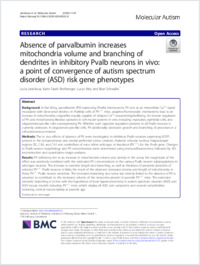Absence of parvalbumin increases mitochondria volume and branching of dendrites in inhibitory Pvalb neurons in vivo: a point of convergence of autism spectrum disorder (ASD) risk gene phenotypes
- Janickova, Lucia Anatomy, Section of Medicine, University of Fribourg, Route Albert-Gockel 1, 1700, Fribourg, Switzerland
- Rechberger, Karin Farah Anatomy, Section of Medicine, University of Fribourg, Route Albert-Gockel 1, 1700, Fribourg, Switzerland
- Wey, Lucas Anatomy, Section of Medicine, University of Fribourg, Route Albert-Gockel 1, 1700, Fribourg, Switzerland
- Schwaller, Beat Anatomy, Section of Medicine, University of Fribourg, Route Albert-Gockel 1, 1700, Fribourg, Switzerland
-
09.06.2020
Published in:
- Molecular Autism. - 2020, vol. 11, no. 1, p. 47
English
In fast firing, parvalbumin (PV)-expressing (Pvalb) interneurons, PV acts as an intracellular Ca2+ signal modulator with slow-onset kinetics. In Purkinje cells of PV−/− mice, adaptive/homeostatic mechanisms lead to an increase in mitochondria, organelles equally capable of delayed Ca2+ sequestering/buffering. An inverse regulation of PV and mitochondria likewise operates in cell model systems in vitro including myotubes, epithelial cells, and oligodendrocyte-like cells overexpressing PV. Whether such opposite regulation pertains to all Pvalb neurons is currently unknown. In oligodendrocyte-like cells, PV additionally decreases growth and branching of processes in a cell-autonomous manner.Methods: The in vivo effects of absence of PV were investigated in inhibitory Pvalb neurons expressing EGFP, present in the somatosensory and medial prefrontal cortex, striatum, thalamic reticular nucleus, hippocampal regions DG, CA3, and CA1 and cerebellum of mice either wild-type or knockout (PV−/−) for the Pvalb gene. Changes in Pvalb neuron morphology and PV concentrations were determined using immunofluorescence, followed by 3D- reconstruction and quantitative image analyses.Results: PV deficiency led to an increase in mitochondria volume and density in the soma; the magnitude of the effect was positively correlated with the estimated PV concentrations in the various Pvalb neuron subpopulations in wild-type neurons. The increase in dendrite length and branching, as well as thickness of proximal dendrites of selected PV−/− Pvalb neurons is likely the result of the observed increased density and length of mitochondria in these PV−/− Pvalb neuron dendrites. The increased branching and soma size directly linked to the absence of PV is assumed to contribute to the increased volume of the neocortex present in juvenile PV−/− mice. The extended dendritic branching is in line with the hypothesis of local hyperconnectivity in autism spectrum disorder (ASD) and ASD mouse models including PV−/− mice, which display all ASD core symptoms and several comorbidities including cortical macrocephaly at juvenile age.Conclusion: PV is involved in most proposed mechanisms implicated in ASD etiology: alterations in Ca2+ signaling affecting E/I balance, changes in mitochondria structure/function, and increased dendritic length and branching, possibly resulting in local hyperconnectivity, all in a likely cell autonomous way.
- Faculty
- Faculté des sciences et de médecine
- Department
- Département de Médecine
- Language
-
- English
- Classification
- Biological sciences
- License
-
License undefined
- Identifiers
-
- RERO DOC 328850
- DOI 10.1186/s13229-020-00323-8
- Persistent URL
- https://folia.unifr.ch/unifr/documents/308674
Statistics
Document views: 140
File downloads:
- pdf: 237
